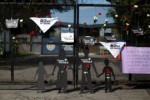The legacy of Pope Francis: Choosing faith over fear
Michael W. Higgins is the Basilian Distinguished Fellow of Contemporary Catholic Thought at the University of Toronto’s St. Michael’s College. His latest book is The Jesuit Disruptor: A Personal Portrait of Pope Francis.
It’s all in the name. When Jorge Mario Bergoglio was elected Pope on March 13, 2013, he chose to be known as Francis.
The first of many firsts that have come to define the Bergoglio papacy, he knew that by choosing a name foreign to the annals of papal appellations he was breaking with convention, just as Albino Luciani had done when he chose the double-barrelled John Paul I.
He knew he needed to explain why he had chosen Francis – and did so at a large gathering of journalists three days after the conclave that elected him. It turned out to be a profound moment, demonstrating his own comfort level with the media, his preference for transparency over speculation and his resolve to embrace the legacy, not only the name, of St. Francis, Il Poverello, the Poor One of Assisi.
Pope Francis, street priest turned tradition-defying pontiff, dies at 88
Pope Francis spent a lifetime serving the poor and challenging Catholic Church orthodoxy
“For me, he is the man of poverty, the man of peace, the man who protects creation,” he said. “How I would like a church which is poor and for the poor.”
Pope Francis set out to rid the modern papacy of pomp and to make it more inclusive. His informal style and simplicity alienated many conservatives but endeared him to millions of Catholics. Lucy Fielder has more.
Reuters
Creating a church of and for the poor proved a titanic task for Francis. Bishops and cardinals accustomed to fine living, sumptuous housing and the perks and privileges ratified by centuries of convention were stunned to discover that the newly elected Pope from Argentina preferred a stripped-down papacy – not the Apostolic Palace, the official residence of popes, but the comparatively simple digs of the Casa Santa Marta. Protocol was streamlined. The princely dignities of office much modified.
By taking the name of Francis, Bergoglio signalled his intention to direct the church in new ways and to do so from the very beginning of his Petrine ministry.
As the first Pope from the Jesuit order, he elected to make his inaugural papal visit to Lampedusa, an island off the southwest coast of Italy, to visit migrants from North Africa who had braved rough, sometimes deadly seas to escape tyranny, war and poverty. These were the ones he was called to serve, and this too was a first.
Pope Francis greets the crowd during his his inaugural papal visit to the Sicilian island of Lampedusa, to pray for migrants lost at sea in July, 2013.Gregorio Borgia/The Associated Press
The two previous popes, on their premiere trips outside the Vatican, had gone to their homelands – Poland and Germany, respectively. But Francis, to the dismay of his officials, opted for Lampedusa and, in doing so, sent a message to the world.
This trip wasn’t a photo op, a media ploy, a dramatic papal visit to a territory distant from Vatican concerns. On the contrary, the gesture was a visually arresting pilgrimage to the peripheries – and therefore a key component of the Francis agenda.
Throughout his papacy, Francis repeatedly underscored the role of the margins – geographical, political, economic, cultural and theological. For too long, those on the edges had been made to feel either alienated or of secondary concern. No longer. The peripheries became the focal point of the Pope’s priorities.
From the outset, many in the Vatican’s head office – the Roman Curia – sensed that their new boss was not going to follow established ways; that he would opt for spontaneity........






















 Toi Staff
Toi Staff Gideon Levy
Gideon Levy Belen Fernandez
Belen Fernandez Andrew Silow-Carroll
Andrew Silow-Carroll Stefano Lusa
Stefano Lusa Tarik Cyril Amar
Tarik Cyril Amar Rachel Marsden
Rachel Marsden Robert Sarner
Robert Sarner Constantin Von Hoffmeister
Constantin Von Hoffmeister Mark Travers Ph.d
Mark Travers Ph.d
